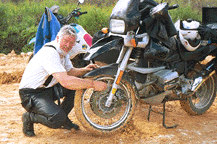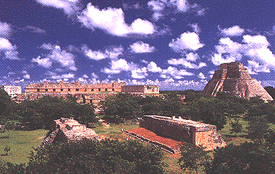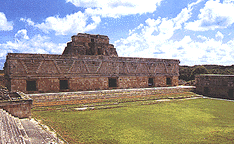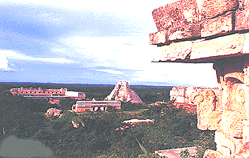La Ruta Maya - Page 3
There are two ways to get to Uxmal from Campeche. The regular road and the "short cut!" Looking at the map we decided to ride north for about 50 miles and then turn east over a a 15 mile stretch of back road to the small village of Muna and then back south a short distance to Uxmal. This route looked to be more "off the beaten track" as well as shorter. The short cut turned into a three hour ride versus the normal one and half hour ride. Little did we know that the 15 mile stretch was mainly a dirt and mud road! We had broken one of the main rules on asking directions in Mexico. The rule says one must ask three different people about the condition of a road and then believe the worst case answer.
 Mud was a problem for the BMW 1100GS - seems like they are prone
to getting the front fender jammed up if too much mud gets trapped between
the fender and tire. No problem though, just a few minutes to clean it
and we were on our way. We agreed we would have taken the road anyway as
it was our first chance to get off the main highway. The small villages
and farms made it worth the extra time!
Mud was a problem for the BMW 1100GS - seems like they are prone
to getting the front fender jammed up if too much mud gets trapped between
the fender and tire. No problem though, just a few minutes to clean it
and we were on our way. We agreed we would have taken the road anyway as
it was our first chance to get off the main highway. The small villages
and farms made it worth the extra time!
Arriving in Uxmal we chose to stay at the Hotel Arqueological, about 100 meters from the entrance to the ruins. This Hotel is very much in harmony with it's surroundings! Very open in it's design, gardens, jungle type swimming pool, outside eating patios and inviting in every regard. The hotel is owned and operated by Club Med.
Robert and I decided to take about a 20 mile ride to look at some minor ruins at Kabah, Sayil, and Labna. They may be considered minor but we found them to be very impressive and worthy of a special trip. More to come on these three special places!
 Uxmal was an important city during the late Classic Period (600-900
AD) of a region which encompassed the satellite towns of Sayil, Kabah,
Xlapak and Labna. Although Uxmal means thrice Built in Mayan, it was actually
reconstructed five times.
Uxmal was an important city during the late Classic Period (600-900
AD) of a region which encompassed the satellite towns of Sayil, Kabah,
Xlapak and Labna. Although Uxmal means thrice Built in Mayan, it was actually
reconstructed five times.
 Uxmal is the defining example of the Puuc architectural style, which
emphasizes elegant proportions and intricately detailed building exteriors
of cut stones assembled in geometric patterns. Cornices and entryways often
feature beak-nosed representations of the rain god Chac. The detail of
the stonework is even more amazing when one considers the Maya created
their buildings without benefit of metal tools.
Uxmal is the defining example of the Puuc architectural style, which
emphasizes elegant proportions and intricately detailed building exteriors
of cut stones assembled in geometric patterns. Cornices and entryways often
feature beak-nosed representations of the rain god Chac. The detail of
the stonework is even more amazing when one considers the Maya created
their buildings without benefit of metal tools.
 There is much speculation as to why Uxmal was abandoned in about
900 AD. Drought conditions may have reached such proportions that the inhabitants
had to relocate. One widely held theory suggests that the rise to greatness
of Chichen Itza drew people away from Uxmal.
There is much speculation as to why Uxmal was abandoned in about
900 AD. Drought conditions may have reached such proportions that the inhabitants
had to relocate. One widely held theory suggests that the rise to greatness
of Chichen Itza drew people away from Uxmal.
After one and a half days in the Uxmal area we left for Chichen Itza. A map study of the back roads in the Yucatan indicated we could cut cross country and avoid the well traveled tourist road. The ride was fantastic! Many small villages, mainly populated by the Mayan descendants, gave us a rare view of the Yucatan population most tourist don't see. Many of these small villages seemed unchanged from how they might have looked hundreds of years ago. Needless to say, five motorcycles and their "gringo" riders was a strange sight for these people. The weather was great, roads very narrow but virtually free of traffic, and the jungle vegetation made for a unique adventure! We wished it had not ended so soon but within four hours we arrive in Chichen Itza, "The Mother of all Tourist Destinations!"
Up until this point we had seen very few tourists as most of our stops had been at rather remote locations. Now we were back in civilization, four lane roads from Cancun and an international airport within three miles. We looked at our guide books and decided to try the Piramide Hotel in the small town of Piste. It is only 2 km from the ruins but might keep us out of the tourist buses and vans from Cancun - we were wrong! The hotel is run by an American lady whose father used to excavate at Chichen Itza many years ago. It is a comfortable and well kept hotel and one we can recommend. Certainly a lot less expensive then the ones next to the ruins.
Return to KLR Home Page